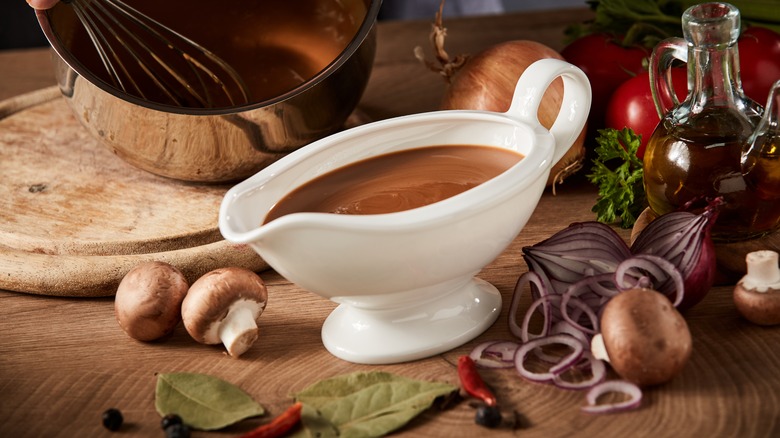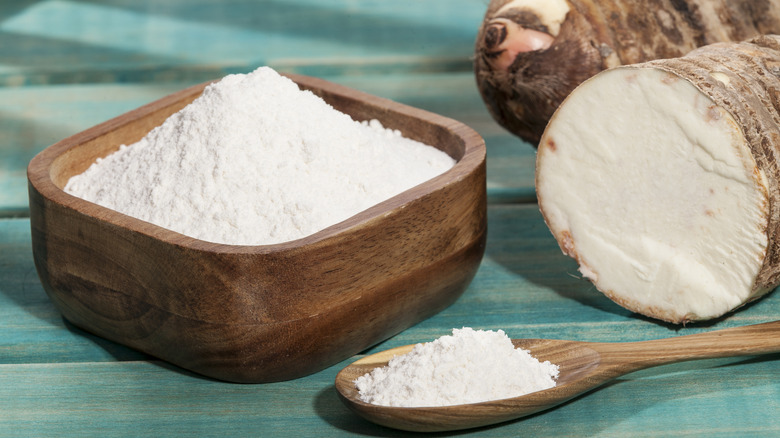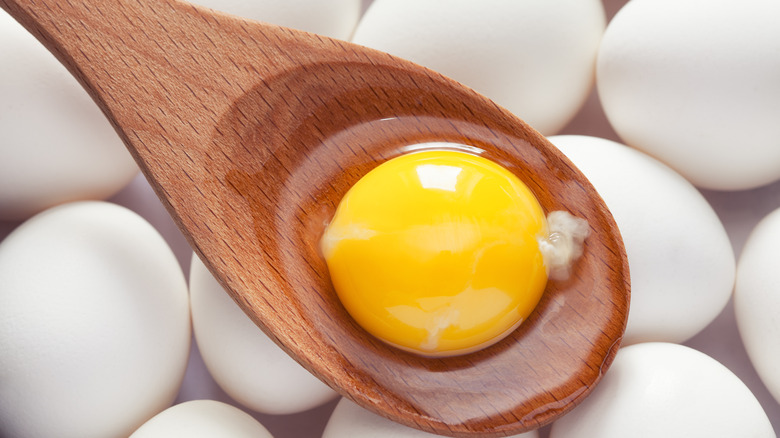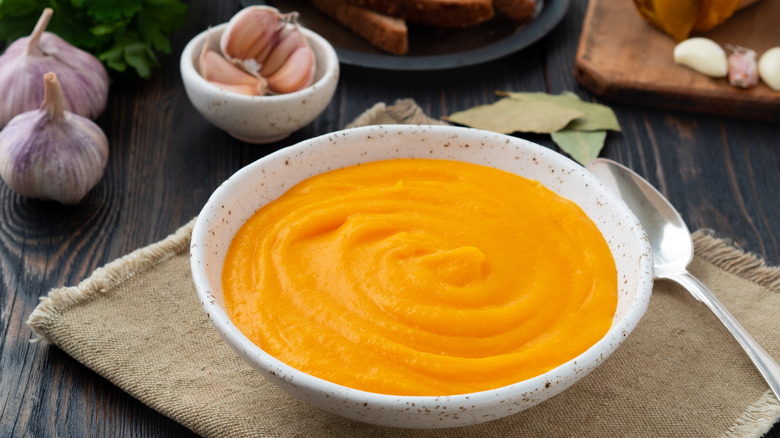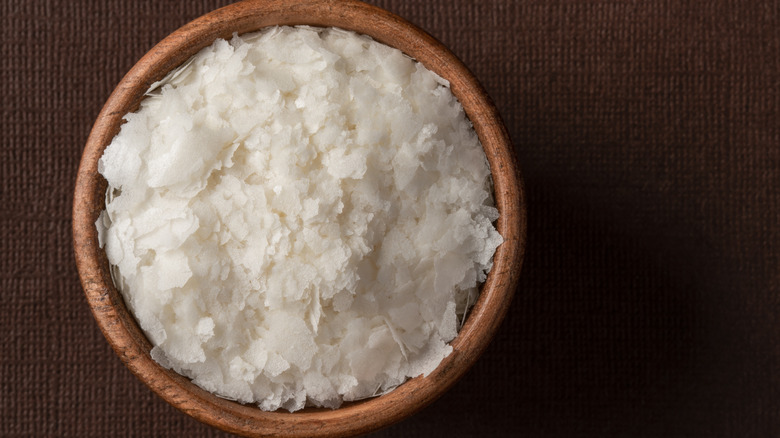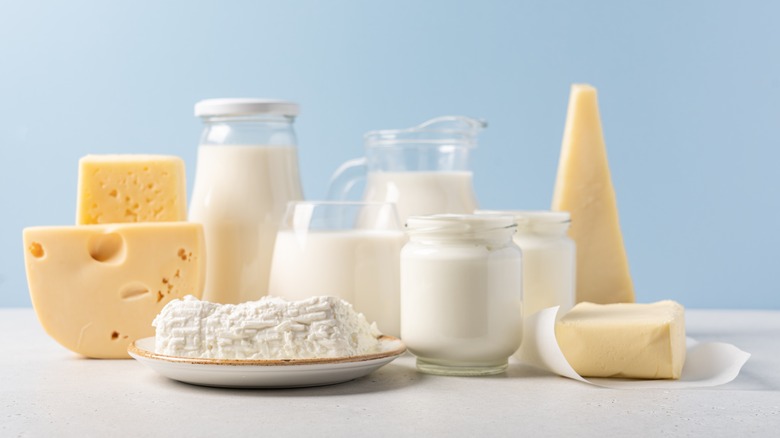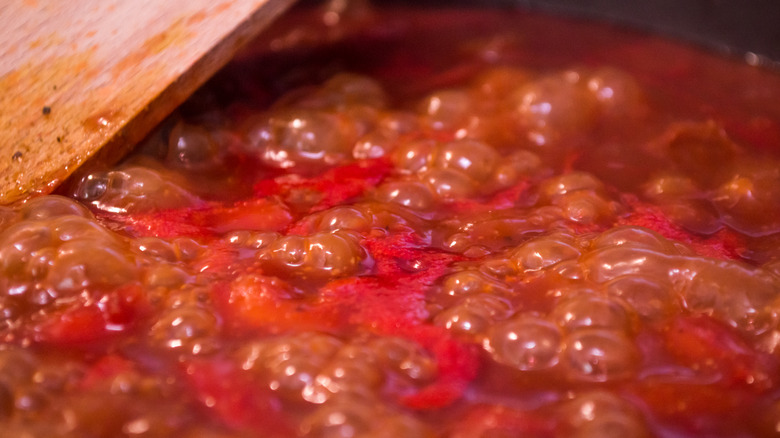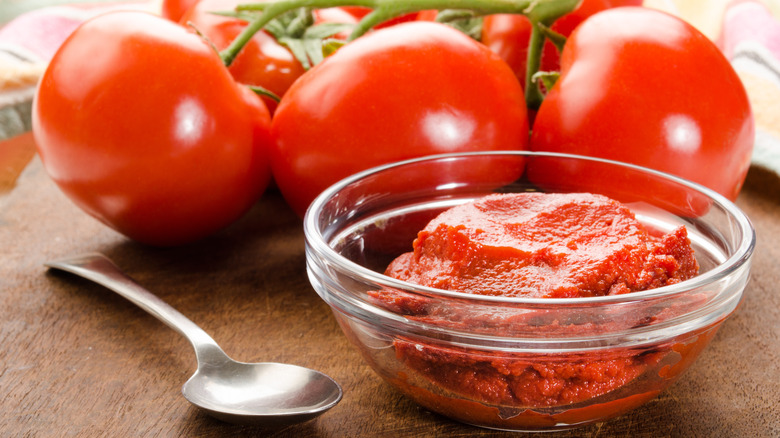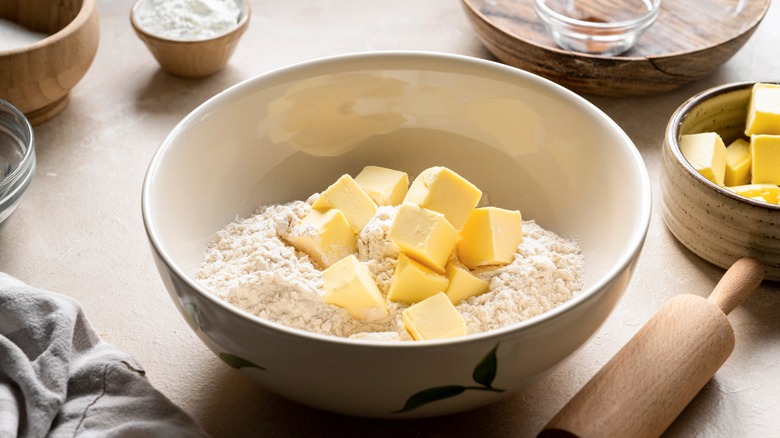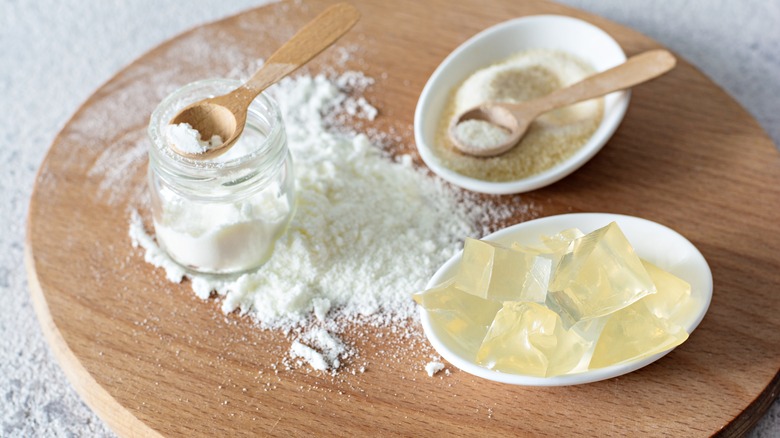The Best Tips For Fixing Thin Sauces
Nothing is worse than cooking up lunch, dinner, or even brunch with a sauce that should be creamy, thick, and delicious, only to end up with something that doesn't cut it. Fortunately, there are plenty of ways to fix this problem, depending on your preferences.
Leaf TV explains that a properly thickened sauce should coat the back of a spoon. This is a pretty simple way to check consistency. When deciding what fix to use for a sauce that is too thin, you need to consider its elements. For example, you wouldn't want to use milk or yogurt to thicken a non-cream-based sauce.
Food allergies and sensitivities will also play a role. You'll need to avoid milk-based products for those who are lactose intolerant. Vegans can also not consume sauces made this way or ones that include eggs. And you'll want to avoid flour and similar ingredients for those with gluten sensitivity or Celiac disease. The good news is that there are ways to thicken your sauces that will work with any type of sauce and any diet or food sensitivities.
Add flour
Flour is the go-to thickener for most cooks. It is economical, easy to find, easy to use, and effective. According to A Life of Geekery, flour is predominantly made of starch, which gelatinizes when combined with liquids. You should cook flour before adding it to sauces. Raw, the flavor is unpleasant, but cooked, it is nutty.
Most people already have this thickener in their pantries or cupboards. This makes it a quick and easy fix for a sauce that's too thin, so long as everyone at the table can eat gluten. There are some things to consider, though. Whole wheat flour, for instance, has a lower starch content than white flour, so you will need to use a bit more if that is what you have on hand.
How much you need to use will depend on your desired thickness, but generally, you'll want to add 2 tablespoons of flour for each liter of liquid. Not using metric measurements? Adding 2 tablespoons of flour for every 4.5 cups of liquid should be roughly equivalent. Flour works best as a thickener when mixed into a slurry. Combine it with cold water before adding it to your sauce. This will separate the starch granules, making it more effective. Let it simmer so the flour can fully incorporate with the sauce.
Stir in some cornstarch or arrowroot
Cornstarch or arrowroot powder should be your go-to options if you need your sauce to be gluten-free. Besides thickening without the allergen, these powders will give your sauce a gloss or shine that is highly desirable. You could achieve that same result with butter, but whether that's appropriate depends on your dinner guests' dietary preferences and requirements. And flours create an opaquer finish to your sauces.
You could also use baking powder if you don't have cornstarch or arrowroot powder on hand, but it isn't the best option. It can work well in recipes like chili, but it only works in sauces because it contains cornstarch. So, if you have both on hand, you should opt for pure cornstarch instead. Baking powder has other ingredients that could cause bitter or off-putting tastes to your sauces.
Like flour, you will need to create a slurry before adding cornstarch or arrowroot powder to your sauces. But because it's a more potent thickening agent, you won't need to use as much. Use 1 tablespoon of cornstarch and 2 tablespoons of cold water to start (via The Typical Mom). You can always add more if needed, but you can't undo what you've already done, so it's best to start with small doses. Add to your sauce and simmer until it reaches your desired thickness. And add more slurry as needed.
Incorporate egg yolks
This is a trickier prospect but will pay off once you master the skill of tempering your egg yolks and thickening sauces with them. It's also an excellent option if you're avoiding gluten and dairy, making the prospect of thickening a sauce daunting, according to Mark's Daily Apple.
Tempering your eggs is essential because you want to avoid scrambling them but not create a runny mess by leaving them undercooked. Start by cracking your eggs and separating the yolks into a bowl. Beat them and then gradually add some of the sauce, whisking them together. You'll need to start with about 1 cup of sauce, and once they begin to incorporate, add some more to ensure the egg yolks are warming.
Lower the heat in the pot with your remaining sauce to avoid curdling your egg yolk mixture. Stir the tempered egg yolk mixture back into your sauce to thicken it.
Mix in some puréed vegetables
Iron chef Alex Guarnaschelli has a sneaky trick for thickening gravy that you can use for just about any sauce. Instead of using fats like butter and oil, she purées vegetables and adds them to her sauces. It is a healthier thickener than fats and helps get a few extra servings of veggies into your daily diet.
Another benefit to using vegetables instead of other thickening agents? Even with a slurry, powders like flour, cornstarch, and arrowroot can lead to lumps in your sauces or gravies. If your sauce is gravy or Italian, you can use Alex's suggestion of adding puréed onions and garlic instead of a traditional thickening agent. You'll need to roast them both until they're tender, then purée them and mix them into your sauce.
But what if you don't have the type of sauce that works with garlic and onion flavors? Not to worry. You can still use this trick by swapping out your vegetables. Try carrots and celery for a purée that doesn't contribute specific flavors to your sauces.
Plump things up with potato flakes
Looking for another vegetable-laden way to thicken your sauces? Try adding potato flakes. These work perfectly because you can grind them finer or leave them coarse to create a sauce that's the perfect consistency. And they're a bit less work than adding roasted and puréed vegetables to your sauces.
Potato flakes are easy to pick up at any store, and you may already have them on hand. They're also easy to use. Unlike flour, they are gluten-free. And unlike cornstarch and arrowroot powders, you don't need to make them into a slurry before adding them to your sauces. Just mix them in a spoonful at a time until you reach the desired consistency. Make sure not to overindulge, as these bulk up and thicken your sauces quickly. It's easy to overdo this trick.
Potato flakes work best with country-style sauces, like gravies (per Our Everyday Life). One tablespoon of potato flakes per 1 cup of liquid tends to be a successful ratio, but you should add small amounts until you get the exact thickness you want.
Bring it all together with butter (or heavy cream or sour cream)
Not only will butter help thicken your sauces, but if you're using it for pasta, it will also help that sauce cling to your pasta. Add butter to create a thick sauce that hugs every strand of your spaghetti. You'll need to add it while the sauce is cooking and then finish your pasta in the sauce for the best flavor and adherence.
Another dairy product you can use to thicken your sauces is sour cream. This works particularly well with pan sauces (via Lifehacker). You should add the full-fat variety to wine and hot pan drippings. If you don't consume alcohol, you can still use sour cream, but you'll need broth to deglaze the pan.
Yogurt will also work in a pan sauce but opt for the full-fat version again. Both yogurt and sour cream will work in cream sauces but not so well in other varieties. On the other hand, the butter will work no matter what type of sauce you make.
Reduce by simmering over low heat
Thickening your sauce by reducing it involves simmering overheat for an extended period. Another benefit to choosing this method is that it makes the flavor of your sauces more robust, according to More Than Gourmet. Simmering reduces your sauces, and there are four ways to successfully accomplish this. The first starts by adding wine or stock to your pan after the entrée you cooked in it has been removed. Then reduce the amount of liquid in the pan by half before adding butter, cream, or olive oil, and let it thicken on the stove before adding your main protein back into the pan.
The second is a slow and simple process. And rushing it could ruin your reduction. Use a wide pan and low heat for the best results. It could take 15 to 30 additional minutes, and you'll want to keep a close eye on the sauce to avoid overcooking. Finally, consider reducing more than once. You could start with wine and finish with stock. In either case, reducing or simmering is a quick and painless way of thickening your sauce that doesn't necessarily require adding anything to the sauce you wouldn't already have used to flavor it.
Thicken it with tomato paste
This tip will only work with a tomato-based sauce, but if that's what you're making, this is one of the easiest ways to thicken your sauce. It works especially well for spaghetti sauce since tomato paste is essentially a super-concentrated tomato sauce, at least the original Italian variety known in the United States as marinara, according to The Kitchen Community. It adds mass without increasing your sauce's volume.
For the best flavor, you'll want to "activate" the paste, which is done by frying it in a skillet with some oil. This gives the paste a duskier flavor that better contributes to your final sauce.
If you're not going to prepare your tomato paste this way beforehand, you can just add it in, but the flavors of your final sauce will need some adjustments (via Loaves and Dishes). You may need to add sugar, garlic, Italian seasonings, or salt and pepper to even out the taste of your tomato sauce if you are adding tomato paste to your tomato sauce.
Make it better with beurre manié
This is a combination of a couple of the other suggestions on this list — butter and flour. The difference is that this treatment is like a roux, only "raw," according to Lifehacker. A traditional roux involves frying your flour in butter. Beurre manié uses these same ingredients uncooked. Traditionally, you mash the two together into a paste. But there's a simpler way of making a beurre manié.
Cut 1/2-inch pieces of butter and coat them in flour. You'll need about 3 tablespoons of butter per 1 tablespoon of flour. Once coated, toss your premade beurre manié in a bowl in the fridge. That way, it's on hand the next time you have a sauce that's a bit too thin. When that happens, add them in one at a time, then whisk until the sauce is smooth.
You can make this "kneaded butter" with plant-based spreads, too, if you're lactose intolerant or vegan (via Rouxbe). You will, however, need to adjust the amounts used. Use 2 tablespoons of flour for every 3 tablespoons of plant-based spread. Add the beurre manié in small doses to sauces or liquids at a "gentle boil." If the sauce isn't boiling, it won't thicken. Add more as needed until your sauce is thickened appropriately.
Perk things up with pectin
You may have heard of pectin if you make your own jams and jellies. The one you use to thicken sauces works the same way, but you should look for the sugar-free variety if possible, according to Our Everyday Life. If you're making a sweet sauce, either will work. But for savory options, look for "high-methoxyl" or sugar-free pectin, so it doesn't adversely affect the flavor of your sauce. This works well because it takes only small amounts to be successful and works quickly. It also won't affect the taste of what you're thickening. Season your sauce before adding the pectin because you need to turn off the heat shortly after adding it. If you try to season after the pectin, your spices may not have enough time to flavor your sauce.
You'll need ¾ teaspoon of no-sugar pectin for each cup of savory sauce, plus 2 tablespoons of milk if your sauce isn't dairy-based. This is what activates the no-sugar pectin. If you're making a sweet sauce, add 2 tablespoons of regular pectin for each cup of sugar in your sauce. You can buy pectin at most grocery stores and even big box stores. Check the section with the puddings and Jell-o mixes (via Thrive Cuisine). If you don't want to buy it packaged, you can make it yourself, though you should only use the homemade variety in your sweet sauces. Pectin can be made at home using fruit, which contains natural sugars.
Get it together with gelatin or collagen peptides
Gelatin and collagen are similar compounds, and each will work to fix a sauce that turned out too thin. Wise Choice Market explains that the difference is how they work. Gelatin will take on a gel consistency when chilled, so it should be used sparingly when thickening sauces. Collagen does not, making it a little easier to use as a thickening agent in your sauces. Both are unflavored and can be used with any type of sauce.
Consuming collagen and gelatin both have health benefits, too. Connective tissues in the body use collagen or gelatin to help with formation, as do bones and joints. Even your digestive tract benefits from consuming them.
You'll need to mix the gelatin with water before adding it to your sauces (via Our Everyday Life). Start with 2 tablespoons of cold water, then add 1 ½ to 4 ½ teaspoons of gelatin per 1 cup of sauce, depending on the consistency you're hoping to achieve. Sprinkle the gelatin on top of the water and let it sit briefly before whisking together. Once blended, let it sit a bit longer before adding it to the sauce. Stir to incorporate and then remove from the heat.
Use Greek yogurt
The thickening agent that best suits your purposes depends on your sauce. Yogurt won't work in all the sauces you want to thicken, but it's an ideal choice for a curry. Greek yogurt is a perfect way to improve the consistency of your sauce without adversely affecting its flavor.
This is especially important for sauces like curry that can't be effectively thickened in other ways without compromising taste. Reducing the sauce, for example, is likely to result in soggy or overcooked proteins and vegetables.
According to Our Everyday Life, there are a few things to remember if you choose this thickening agent. First, you should use a full-fat variety, as low-fat or no-fat varieties are more likely to curdle when you add them to sauces that have been heated. You can also add 1 teaspoon of flour or cornstarch to your yogurt as extra protection against curdling.
Cook your sauce over low heat if you are adding yogurt to it. And let your Greek yogurt come to room temperature, if possible, before using it. You can temper your yogurt first if you're short on time. Ladle some of the sauce into a bowl, stir in your yogurt, and then add it back into the pot.
